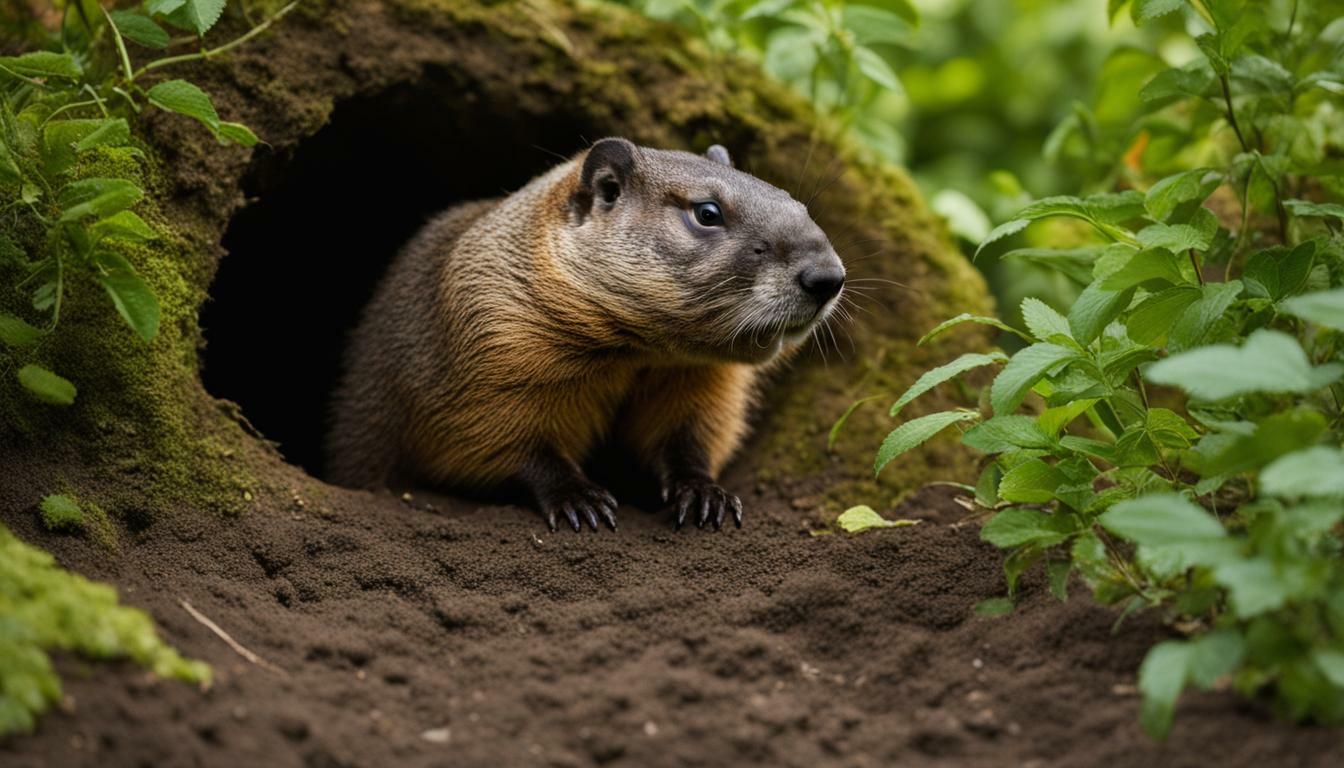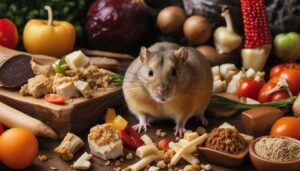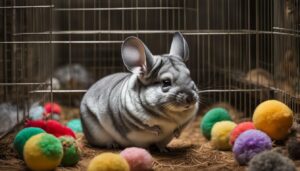If you’ve ever wondered whether groundhogs eat meat, you’re not alone. Let’s explore the groundhog diet and find out if these furry creatures consume animal protein.
Key Takeaways:
- Groundhogs are primarily herbivores, with plant-based foods making up the majority of their diet.
- They prefer grasses, fruits, and vegetables, but may also eat insects such as beetles, worms, snails, and slugs.
- On rare occasions, groundhogs may consume small vertebrates like birds or rodents, but meat is not a significant part of their diet.
- Groundhogs are not aggressive towards humans or pets, and their interactions with dogs are typically characterized by fleeing and hiding.
- To prevent groundhogs from entering your yard, consider using barriers like fences or ultrasonic sound emitters.
Understanding the Groundhog’s Diet
Groundhogs, also known as woodchucks, are primarily herbivores with a diet consisting mainly of grasses, fruits, and vegetables. These cute critters have a preference for plant-based foods, making up the majority of their diet. They spend much of their time grazing on grass, munching on leaves, and enjoying the bounty of fruits and vegetables they find.
While groundhogs are predominantly herbivorous, they do occasionally consume small amounts of animal protein. Insects like beetles, worms, snails, and slugs are sometimes on their menu. It’s not uncommon to find a groundhog indulging in a savory snack of insects, providing a supplementary source of nutrition. However, it’s important to note that these instances are rare, and meat consumption is not a significant part of their overall diet.
The groundhog’s love for plants
Groundhogs have a particular fondness for certain plant-based favorites. They relish the taste of various grasses, particularly those with high nutritional value. Additionally, they enjoy feasting on a variety of fruits, including berries and melons, when available. Vegetables like lettuce, carrots, and cucumbers also make deli
| Plant-Based Favorites | Quantity |
|---|---|
| Grasses | High |
| Fruits (berries, melons) | Moderate |
| Vegetables (lettuce, carrots, cucumbers) | Moderate |
These plant-based favorites provide the groundhog with essential nutrients, keeping them healthy and energized throughout their active months. While it’s fascinating to observe their plant-centric diet, it’s equally important to understand their occasional consumption of small amounts of animal protein.
On rare occasions, groundhogs may venture beyond their herbivorous tendencies and consume small vertebrates. This behavior is not common and primarily occurs when other food sources are scarce. Young birds or rodents may find themselves on the groundhog’s menu during these infrequent instances. It’s important to remember, however, that these occurrences are exceptions rather than the norm.
Plant-Based Favorites
Grasses, including clover and dandelion, constitute a significant part of a groundhog’s diet. These fibrous plants provide the necessary nutrients and fiber for their digestive system. Groundhogs also enjoy feasting on a variety of other plant-based foods, such as wildflowers, leaves, and shoots. Their penchant for vegetables like carrots, lettuce, and beans is well-known. These herbivorous creatures have a particular fondness for fruits, including berries, cherries, and apples.
In addition to grasses and vegetables, groundhogs rely on a diverse range of plants to meet their nutritional needs. They consume different types of seeds and nuts, like sunflower seeds and peanuts, which provide essential fats and proteins. Groundhogs also graze on the bark of trees, especially in the winter months when other sources of food are scarce.
Seasonal Variations in Diet
A groundhog’s diet varies throughout the year, depending on the availability of certain foods. During the spring and summer, when fresh greens are abundant, groundhogs primarily feed on grasses and leafy vegetation. As fall approaches, their diet shifts to include more fruits and seeds. This diet change allows them to store extra fat before going into hibernation during the winter months.
| Plant-Based Favorites | Examples |
|---|---|
| Grasses | Clover, dandelion |
| Vegetables | Carrots, lettuce, beans |
| Fruits | Berries, cherries, apples |
| Seeds and Nuts | Sunflower seeds, peanuts |
| Bark | Bark of trees |
While groundhogs are primarily herbivorous, they do occasionally supplement their plant-based diet with small amounts of animal protein. Insects like beetles, worms, snails, and slugs are known to be part of their occasional meal plan. However, it is essential to remember that these instances are infrequent and not a significant part of their overall diet. Groundhogs are fascinating creatures with diverse food preferences, but their herbivorous nature remains their defining characteristic.
The Surprising Insectivorous Side
While groundhogs are mainly herbivores, they do have an insectivorous side and occasionally feast on beetles, worms, snails, and slugs. These small creatures provide a source of animal protein that groundhogs may consume as a supplement to their primarily plant-based diet. Although their meat consumption is minimal, it demonstrates the adaptability of these furry creatures.
Groundhogs have been observed foraging for insects in gardens and meadows, using their strong claws and sharp teeth to capture their prey. These insectivorous tendencies allow groundhogs to diversify their diet and obtain additional nutrients. However, it is important to note that insects make up only a small portion of their overall food intake.
In their search for insects, groundhogs may disturb the soil, aerating it and contributing to the fertility of the earth. This behavior benefits the ecosystem, as it helps with seed dispersal and the growth of certain plant species. Therefore, groundhogs’ occasional indulgence in a carnivorous meal serves a purpose beyond satisfying their nutritional needs.
| Groundhogs’ Insectivorous Side | Types of Insects Consumed |
|---|---|
| Occasional carnivorous tendencies | Beetles, worms, snails, slugs |
In conclusion, while groundhogs are primarily herbivores, they do exhibit an insectivorous side, consuming small amounts of animal protein through insects. This behavior allows them to diversify their diet and contribute to the ecosystem’s overall health. However, it is crucial to remember that meat consumption is not a significant part of their food intake, with plants remaining the mainstay of a groundhog’s diet.
Rare Occurrences of Carnivory
Although it is uncommon, groundhogs have been known to eat small vertebrates such as young birds or rodents. These instances of carnivory are rare and generally occur when groundhogs are faced with limited access to their regular plant-based food sources. While groundhogs are primarily herbivorous, their opportunistic nature allows them to adapt their diet when necessary.
When groundhogs consume small vertebrates, it is typically in small quantities and as a supplement to their main diet of plant-based foods. Their occasional consumption of animals is likely driven by a need for additional protein and nutrients. Groundhogs have been observed eating young birds, mice, and other small rodents, but such behavior is not frequently seen.
It’s important to note that these rare occurrences of carnivory do not indicate a drastic shift in groundhogs’ dietary preferences. Plant-based foods still make up the majority of their diet, and they are well-adapted to foraging for grasses, fruits, and vegetables.
| Plant-Based Favorites | Insectivorous Side |
|---|---|
| – Grasses | – Beetles |
| – Fruits | – Worms |
| – Vegetables | – Snails |
| – Slugs |
Overall, while groundhogs may occasionally include small vertebrates in their diet, it is important to understand that it is not their primary source of sustenance. Their natural inclination leans heavily towards plant-based foods, and they demonstrate herbivorous behaviors in their daily foraging activities. So, if you happen to witness a groundhog indulging in a less typical meal, remember that it’s just a rare exception to their otherwise herbivorous lifestyle.
Groundhogs’ Meat Consumption in Perspective
It is important to note that while groundhogs may eat meat occasionally, it is not a significant part of their diet, with the primary food source remaining plants. Groundhogs are primarily herbivores, enjoying a diet rich in grasses, fruits, and vegetables. However, they do display some omnivorous tendencies, supplementing their plant-based diet with small amounts of animal protein. Let’s take a closer look at the details.
When it comes to meat, groundhogs are not actively seeking it out. Their preference lies in foraging for plant-based foods, as they are well-equipped with large incisor teeth perfectly suited for gnawing through vegetation. While they may opportunistically consume insects like beetles, worms, snails, and slugs, these small invertebrates make up only a minor portion of their overall diet.
On rare occasions, groundhogs may show carnivorous behavior by consuming small vertebrates such as young birds or rodents. However, these instances are infrequent and not representative of their typical eating habits. The majority of their sustenance comes from plant matter, making them primarily herbivorous creatures.
| Type of Food | Percentage of Diet |
|---|---|
| Plants (grass, fruits, vegetables) | 90% |
| Insects (beetles, worms, snails, slugs) | 5% |
| Small vertebrates (young birds, rodents) | 5% |
It’s important to understand this perspective on groundhogs’ meat consumption. While they may occasionally include insects or small animals in their diet, it represents a small fraction of their overall nutritional intake. So, if you happen to spot a groundhog nibbling on a bug or making a brief foray into meat-eating territory, rest assured that their primary food source remains the plants around them.
Groundhogs and Human Interactions
Groundhogs are generally not aggressive towards humans or pets, but they may be tempted to eat cracked chicken eggs if they come across them. However, it’s important to note that groundhogs primarily rely on plant-based foods for their sustenance. Their diet consists mainly of grasses, fruits, and vegetables, making them herbivores by nature. While they do occasionally consume small amounts of animal protein, such as insects and small vertebrates, it is not a significant part of their diet.
When it comes to interactions with pets, groundhogs usually exhibit a non-confrontational behavior. They are not known to eat cats, debunking the misconception that they pose a threat to feline friends. Their interactions with dogs tend to be characterized by fleeing and hiding rather than aggression. In most cases, groundhogs will try to avoid encounters with larger animals, seeking safety in their burrows or finding cover elsewhere.
Preventing Groundhog Encounters
If you want to keep groundhogs from entering your yard, there are several measures you can take. One effective method is to install barriers such as fences around your property. This can help deter groundhogs from accessing your garden or other areas where they may cause damage. Additionally, using ultrasonic sound emitters can help repel groundhogs by emitting high-frequency sounds that are unpleasant to them.
Taking these preventive measures can help maintain a harmonious coexistence with groundhogs and prevent potential conflicts. By understanding their dietary preferences and implementing strategies to discourage their presence, you can create a peaceful environment for both humans and these furry critters.
| Preventive Measures | Description |
|---|---|
| Install Fences | Creating barriers around your yard or garden can deter groundhogs from entering and causing damage. |
| Use Ultrasonic Sound Emitters | These devices emit high-frequency sounds that are unpleasant to groundhogs, helping to keep them at bay. |
Groundhogs, Cats, and Dogs
Contrary to popular belief, groundhogs are not known to eat cats. Despite their occasional consumption of animal protein, groundhogs do not typically target domestic animals as part of their diet. Instead, their primary food source consists of plant-based foods such as grasses, fruits, and vegetables. While groundhogs may occasionally scavenge for eggs if they come across cracked shells, they pose no direct threat to cats or their well-being.
When it comes to dogs, groundhogs usually exhibit a non-aggressive behavior. Rather than confronting dogs, groundhogs tend to flee and hide when they sense the presence of a canine. Their instinct to retreat and find cover helps them avoid conflicts and potential injury. So, if you happen to spot a groundhog in your yard and have a dog nearby, it’s best to keep a safe distance and let the groundhog find its way back to its burrow.
To summarize, groundhogs are primarily herbivores with a diet focused on plant-based foods. While they may occasionally consume small amounts of animal protein, they do not pose a threat to cats and typically avoid confrontations with dogs. So, rest assured that your beloved feline friends and canine companions are unlikely to be targeted by groundhogs in your area.
|
Facts about Groundhogs |
|
|---|---|
|
Dietary Preferences |
Plant-based foods, occasional insect consumption, rare instances of small vertebrates. |
|
Interaction with Cats |
Not known to eat cats; typically pose no threat to feline companions. |
|
Interaction with Dogs |
Tend to flee and hide from dogs rather than exhibiting aggression. |
Preventing Groundhog Encounters
To prevent groundhogs from entering your yard, there are various measures you can take, such as installing fences or using ultrasonic sound emitters. These methods can help create a barrier that deters groundhogs from accessing your property. Fences should be buried at least 1 to 2 feet deep to prevent groundhogs from burrowing underneath them. Make sure the fence is at least 3 to 4 feet high to discourage groundhogs from climbing over.
If you choose to use ultrasonic sound emitters, these devices emit high-frequency sounds that are unpleasant to groundhogs, causing them to seek out quieter areas. Place the emitters strategically around your yard, focusing on areas where groundhogs are likely to enter or frequent. Be sure to follow the manufacturer’s instructions for proper placement and usage.
In addition to physical barriers and sound emitters, you can also make your yard less attractive to groundhogs by minimizing potential food sources. Keep your lawn well-maintained and free of excess vegetation, as groundhogs are attracted to lush grass and plants. Securely store garbage cans and compost bins to prevent easy access to food waste that may tempt groundhogs.
Table: Groundhog Prevention Methods
| Prevention Method | Description |
|---|---|
| Fencing | Install fences buried 1-2 feet deep and 3-4 feet high to create a physical barrier. |
| Ultrasonic Sound Emitters | Use devices that emit high-frequency sounds to deter groundhogs from entering your yard. |
| Yard Maintenance | Keep your lawn well-maintained and free of excess vegetation to make your yard less attractive to groundhogs. |
| Garbage and Compost | Securely store garbage cans and compost bins to eliminate potential food sources. |
By implementing these preventative measures, you can reduce the likelihood of groundhog encounters in your yard. Remember, while groundhogs may occasionally eat small amounts of meat, their primary diet consists of plant-based foods. By creating an environment that is less appealing to groundhogs and using deterrents, you can enjoy a groundhog-free yard.
Conclusion
In conclusion, while groundhogs may occasionally consume small amounts of animal protein, their primary diet consists of plant-based foods, making them primarily herbivores. Groundhogs enjoy munching on grasses, fruits, and vegetables as their main sources of sustenance. However, they do have a taste for insects like beetles, worms, snails, and slugs, which they may snack on from time to time. Although rare, groundhogs have been known to devour small vertebrates such as young birds or rodents when the opportunity arises. Nevertheless, it is important to note that meat is not a significant part of their diet and is only consumed on occasion.
When it comes to interactions with humans and pets, groundhogs are generally non-aggressive and pose no threat. While they may be attracted to chicken eggs if they come across cracked ones, they are unlikely to bother cats. In the presence of dogs, groundhogs tend to exhibit evasive behavior, typically opting to flee and find a safe hiding spot.
If you want to prevent groundhogs from making their way into your yard, there are a few effective strategies you can employ. Utilizing barriers like fences can help keep these critters at bay, ensuring they don’t have easy access to your plants and vegetables. Additionally, using ultrasonic sound emitters can deter groundhogs from venturing too close to your property, encouraging them to seek food elsewhere.
FAQ
Do groundhogs primarily eat plants?
Yes, groundhogs are primarily herbivores and their diet mainly consists of plant-based foods such as grasses, fruits, and vegetables.
Do groundhogs ever eat meat?
Yes, although not common, groundhogs may occasionally consume small amounts of animal protein. Their meat consumption is not a significant part of their diet.
What kind of insects do groundhogs eat?
Groundhogs may eat insects like beetles, worms, snails, and slugs. However, their diet primarily consists of plant-based foods.
Do groundhogs eat small vertebrates?
Groundhogs have been known to consume small vertebrates like young birds or rodents, but this is rare and not a regular part of their diet.
Are groundhogs aggressive towards humans or pets?
No, groundhogs are not aggressive towards humans or pets. They prefer to flee and hide when confronted.
Do groundhogs eat cats?
No, groundhogs do not eat cats. They are herbivores and their interactions with cats are typically characterized by fleeing and hiding.
How can I prevent groundhogs from entering my yard?
You can use barriers like fences and ultrasonic sound emitters to deter groundhogs from entering your yard.




